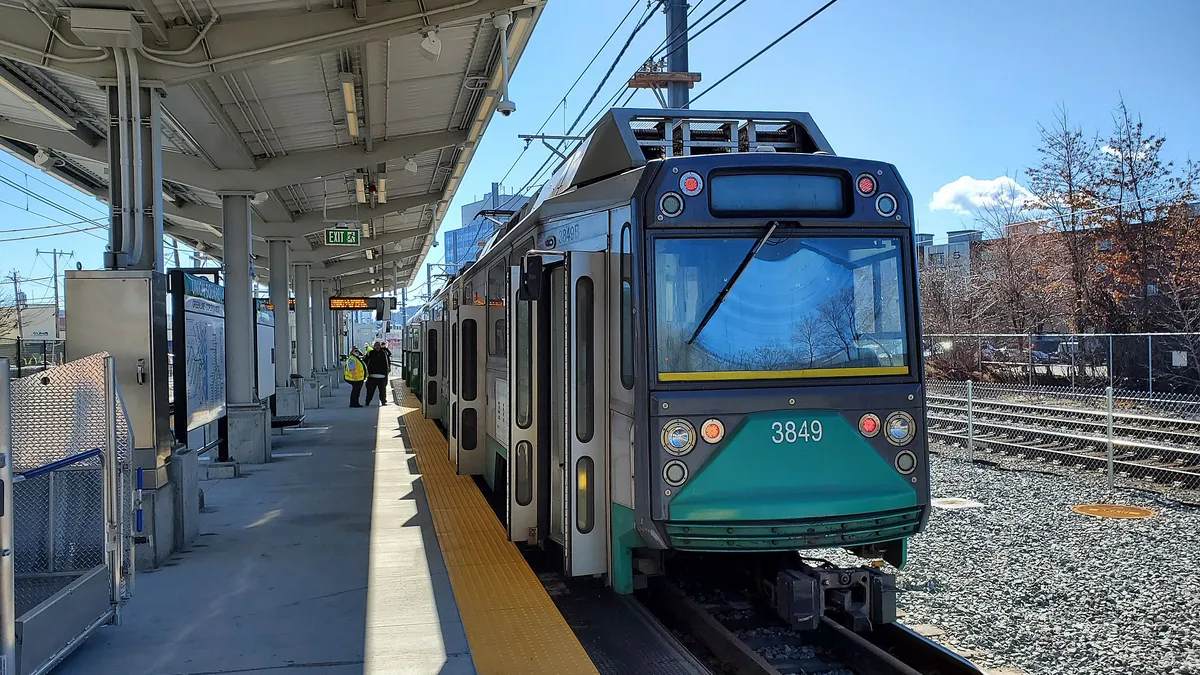Dive Brief:
- Contractors need to repair two-thirds of the rails on Boston’s newly opened, $2.3 billion Green Line Extension, the Massachusetts Bay Transportation Authority’s general manager said last week, because the rails were placed too narrowly. The joint venture leading the project — GLX Constructors, composed of Fluor, The Middlesex Corp., Herzog and Balfour Beatty — will regauge the faulty tracks.
- Half of the 0.7-mile Union Square branch and 80% of the 3.7-mile Medford branch need repairs, though MBTA General Manager Phil Eng told the Boston Globe, “it’s the whole length of the project that I believe needs to be regauged to be back within the contract requirement.” He said that did not mean the trains are running unsafely, but it did force them to slow down.
- The 4.4-mile extension from Cambridge into Somerville and Medford is the newest part of the light rail system known as the T. Construction started in 2018 and wrapped in December 2022. Eng said that GLX Constructors aims to start repairs on Nov. 1 and the process could take weeks.
Dive Insight:
In an Oct. 19 press conference, Eng said the contractor should cover the expense of the repairs, but the agency has not yet determined the cost. An MBTA representative told Trains.com the agency will hold discussions with the builders as part of closing out their contract.
“The problem is tied to the fabrication of the ties and the plates,” Eng told the Boston Globe, and the plates were “pre-installed.”
A review of project records found that GLX construction crews and inspectors first identified instances of “tight gauge” back in April 2021, Eng said. However, construction continued and the project opened in December 2022 with thousands of narrow-gauge areas outside specifications, and it’s unclear how the problems persisted despite quality-control inspections.
Contractors fixed the worst problems with out-of-gauge track before opening in December 2022, the Boston Globe reported, but other problems became public last month when MTBA limited the Green Line’s light rail speeds to as low as 3 mph at 29 locations. The MBTA has since fixed those spots.
MBTA is working with GLX Constructors to correct the rest of the problem, which will entail repositioning tie plates by unscrewing bolts from the plates on one rail, filling the existing holes in crossties, drilling new holes and finally bolting the plates in at the correct gauge.
Construction Dive reached out to GLX Constructors for comment but did not hear back by publication time.
Not the project’s first problem
In August, the construction companies that built the Boston MBTA Green Line Extension filed a lawsuit against New York City-based engineering firm STV, claiming its allegedly faulty designs caused more than $35 million in cost overruns — however, issues with track design were not among the complaints. The plaintiffs said that STV failed to reimburse GLX for unexpected costs, as stipulated in their contract, and are seeking $35 million. STV said it stands by its design.
The GLX project’s history stretches back to 1980 when research first began. MBTA announced a plan in 1990, but later scrapped due to budget overruns. The state began planning the extension again in 2007 and awarded a building contract to White-Kiewit-Skanska in 2013. It fired the contractors after the work went over budget, and put the project on ice.
In 2016, the MBTA scaled back the project and rebid it. GLX Constructors nabbed the design-build contract in 2017 and started construction in 2018, but had to pause work yet again when the COVID-19 pandemic hit.
The GLX project’s 2022 opening puts nearly 80% of the population of Somerville, Massachusetts, within walking distance of a station — a percentage that formerly stood at less than 20%, according to MBTA — and it will reduce vehicle miles traveled by nearly 26,000 miles each day. The agency predicts about 45,000 daily riders will use the seven new Green Line stations by 2030.












